Görlitz
| Görlitz | |
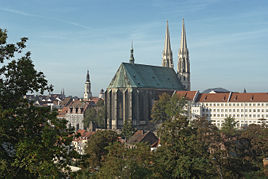 |
|
| Coat of arms | Location |
 |
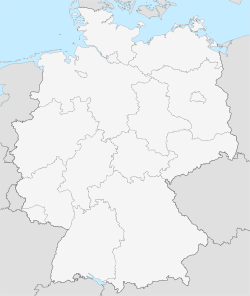 |
| Administration | |
| Country | Germany |
|---|---|
| State | Saxony |
| Admin. region | Dresden |
| District | Görlitz |
| Town subdivisions | 10 town- und 8 village-quarters |
| Lord Mayor | Joachim Paulick (CDU) |
| Basic statistics | |
| Area | 67.22 km² (26 sq mi) |
| Elevation | 199 m (653 ft) |
| Population | 56,724 (30/12/2007)source |
| - Density | 844 /km² (2,186 /sq mi) |
| Other information | |
| Time zone | CET/CEST (UTC+1/+2) |
| Licence plate | GR |
| Postal codes | 02826–02828 |
| Area code | 03581 |
| Website | www.goerlitz.de |
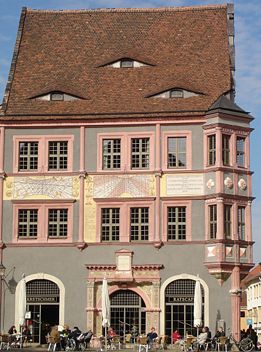
Görlitz ([ˈɡœɐ̯lɪʦ]) is a town in Germany on the Lusatian Neisse River, in the Bundesland (Federal State) of Saxony. It is opposite the Polish town of Zgorzelec, which was a part of Görlitz until 1945. Historically, Görlitz belongs to the region of Upper Lusatia and Silesia. Today it is the easternmost town in Germany. It is the capital of the district of Görlitz.
Contents |
History
As a small village named Gorelic in the region of Upper Lusatia, it was a part of Bohemia. The date of the town's foundation is unknown. However, Goreliz was first mentioned in a document from the King of Germany, and later Holy Roman Emperor, Henry IV in 1071. This document granted Görlitz to the Diocese of Meissen, then under Bishop Benno of Meissen. Currently, this document can be found in the Saxony State Archives in Dresden[1]. The origin of the name Görlitz is derived from the slavic word for "burned land,"[2] referring to the technique used to clear land for settlement. Zgorzelec and Czech Zhořelec has the same derivation. In the 13th century the village gradually became a city. Due to its location on the Via Regia, an ancient and medieval trade road, the settlement prospered.
In the following centuries it was a wealthy member of the Lusatian League, which consisted of Bautzen, Görlitz, Kamenz, Lauban, Löbau and Zittau. In 1352 during the reign of Casimir the Great, colonists from Görlitz founded the town of Gorlice in southern Poland near Kraków.
After suffering for years in the Thirty Years' War, the region of Upper Lusatia (including Görlitz) was accorded to the Electorate of Saxony in 1635. After the Napoleonic Wars, the 1815 Congress of Vienna transferred the town from the Kingdom of Saxony to the Kingdom of Prussia. Görlitz was subsequently administered within the Province of Silesia, and, after World War I, the Province of Lower Silesia, until 1945.
Near the end of World War II, German troops blew up all bridges crossing the Lusatian Neisse. The redrawing of boundaries in 1945 — in particular the relocation of the German-Polish border to the Oder-Neisse line — divided the town. The right bank became part of Poland and was named Zgorzelec in 1948, while the main portion became part of the German state of Saxony. When the East German states were dissolved in 1952, Görlitz became part of the Dresden Bezirk (region), but the states were restored upon German reunification in 1990.
On June 27, 1994, the town became the seat of the Roman Catholic Diocese of Görlitz.
In 2002 Lake Berzdorf, located south of Görlitz, began to flood. The Altstadtbrücke (literally old town bridge) between Görlitz and Zgorzelec was rebuilt in 2003-04. It was officially opened on October 20, 2004. As soon as Poland signed the Schengen Agreement (December 20 2007), movement between the two sides of the river has once again become unrestricted, since border controls were eliminated.
Culture
Today Görlitz and Zgorzelec, two towns on opposite banks of the narrow river, get along well. Two bridges have been rebuilt, a bus line connects the German and Polish parts of the town, and there is a common urban management, with annual joint sessions of both town councils.
The town has a rich architectural heritage (Gothic, Renaissance, Baroque, Historicist, Art Nouveau), which was — in contrast to most other German cities — not destroyed during World War II. One example of this rich architectural heritage is the Schönhof, which is one of the oldest civil renaissance buildings in Germany.
In 2006 the twin city Görlitz/Zgorzelec applied to be the European City of Culture 2010. It was hoped that the concept of Polish-German cooperation would be sufficient to convince the jury, but Essen won the award. Görlitz placed second. The campaign was renamed City of Culture to further German-Polish relations and to attract tourists from all over the world.
Bringing new vitality to the city centre.
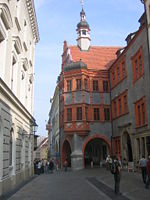
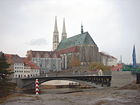
In an effort to let people outside of Görlitz gain a better idea of what life may be like in Görlitz, it has been reported that, as part of a research project, renovated flats in the city centre are being offered for a one week 'trial living' period to families, young couples and singles. This is to help decide if the abundance of unlived in buildings in Görlitz's city centre have a useful life as renovated accommodation, since too many of such buildings are becoming dilapidated and unloved, which makes it ever more difficult to attract new life and vitality into the city centre.
The popularity and enthusiastic reports from those who have taken up the offer of the 1 week 'trial living' has prompted the likelihood of a 6 week 'trial living', to be introduced in the early months of 2009 to tie in with the availability of new renovations.
People
- Jakob Böhme (1575-1624), philosopher
- Johann Christoph Brotze (1742-1823), educator
- Oskar Morgenstern (1902-1977), economist
- Hans-Jürgen Dörner (born 1951), football player and coach
- Jens Jeremies (born 1974), football player,
- Michael Ballack (born 1976), football player
External links
References
- ↑ Görlitz and Diocese of Miessen -- http://www.findcity.de/02826ca/?p=00000002
- ↑ "Placenames of the World" by Adrian Room, McFarland Pub. 2003 page 140
|
|||||||